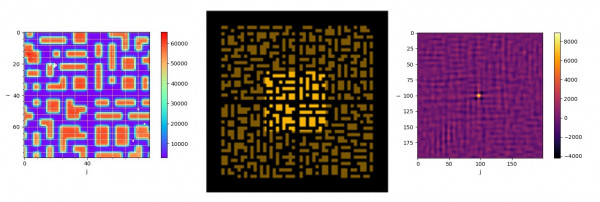ECLAIRs and MXT, the two French telescopes of the SVOM mission, ready to leave for China
Initiated in 2006, approved in 2013 by the French and Chinese leaders, the SVOM (Space-based Multi-band Variable astronomical Objects Monitor) mission will take off in June 2023 from the Chinese base of Xichang, with two French-designed instruments on board: ECLAIRs, developed by researchers and engineers from IRAP, CEA, APC (Laboratoire AstroParticule et Cosmologie) in particular, under the project management of CNES, and MXT. Objectives: to detect gamma-ray bursts, the most energetic phenomena in the Universe, and then to locate their source of emission: massive stars at the end of their life, which, after having ejected their external envelope, collapse on themselves to give birth to black holes. Some of these stars are located at the edge of the Universe, and their radiation provides information about the first generations of stars. Both telescopes, currently in clean room at CNES, will be delivered to China in April 2022.
Designed at IRAP in collaboration with CEA, APC and CNES, the ECLAIRs telescope will carry out the first detection of gamma-ray bursts from space, and will then determine their celestial coordinates: “In low orbit (625 km altitude, inclination of 30 degrees), the SVOM satellite will observe one sixth of the sky. These colossal explosions release in a few seconds the same energy that our Sun will release during its entire life. We expect one or two gamma-ray bursts per week, so we can’t miss them,” explains Jean-Luc Atteia, an astronomer at IRAP and the instrument’s scientific director. ECLAIRs uses the so-called coded mask technology, developed jointly by the CEA and the CESR component of IRAP in the 1980s for the SIGMA space telescope, then optimized for the needs of the ESA Integral telescope: when gamma rays illuminate the mask, they project a unique pattern onto the detection plane; this “QR code” makes it possible to reconstruct the direction of the rays and thus the position of the source.


Left: image recorded by the detector. Right: decoded image. Credit SVOM
As soon as a gamma-ray burst will be detected by ECLAIRs, an alert will be triggered. The satellite will then reorient itself to allow the two telescopes it carries to point towards the event. Among these instruments is the French designed MXT (Microchannel X-ray Telescope): “Our telescope is inspired by the vision of crustaceans in the sea bed: thanks to its vision by reflection (and not by refraction as in humans) the lobster can capture the maximum amount of light with efficiency and in all directions,” says Diego Götz, researcher at the CEA and scientific manager of the instrument.
In addition, the alert triggered by ECLAIRs will be transmitted by the satellite to a network of 47 terrestrial VHF antennas designed by CNES, currently being deployed in some 40 countries in tropical areas. In turn, these antennas will transmit the alert to the SVOM science center (CEA, Saclay), which will relay the information in real time to a ground-based Wide Angle Camera (GWAC) and to robotic telescopes installed in China and Mexico. The latter will study the event in the visible range and check the coordinates of the gamma-ray burst obtained by the ECLAIRs and MXT space telescopes. All these operations will have to take place in only a few minutes!
In the case that one of these bursts presents interesting characteristics, the scientific staff would mobilize the very large telescopes on the ground – Chile, Hawaii, in order to carry out the spectrometric analysis of the burst, to deduce its distance to the Earth as well as its energy, and to study the properties of the galaxy in which it occurred. This will concern for example the bursts that appeared in the young universe, when it was only 5% of its current age, or those associated with the detection of gravitational waves.
Further Resources
- Scientific paper : The SVOM Mission by J-L. Atteia (1), B. Cordier (2), J. Wei (3) (for the SVOM Collaboration, (1) IRAP, Univ. Toulouse, CNRS, CNES, UPS, Toulouse, France, (2) Lab AIM – CEA, CNRS, Univ. Paris-Saclay, France, (3) Key Laboratory of Space Astronomy and Technology, Chinese Academy of Sciences, Beijing, People’s Republic of China) https://arxiv.org/abs/2203.10962
- CEA Press Release : Mission spatiale SVOM : livraison des instruments français à la Chine.
- Press Review :
- Toulouse : une mission franco-chinoise à la recherche des messages des premières étoiles de l’Univers (La Dépêche).
- Toulouse. Mission SVOM : les télescopes français pour sonder le cosmos sont prêts (France 3 Occitanie)
- Un sursaut gamma, c’est quoi ? (Next Impact)
- Deux télescopes assemblés à Toulouse pour découvrir les premières étoiles (Le Parisien)
- Espace : Deux instruments toulousains à bord de la mission d’enquête sur la mort des premières étoiles (20minutes)
- Les instruments français de SVOM, à la recherche des sursauts gamma ! (Clubic)
- Toulouse. Deux télescopes enquêtent sur la mort des premières étoiles (Le Journal Toulousain)
- SVOM, cette mission spatiale franco-chinoise à suivre de près (L’Usine Nouvelle)
IRAP Contacts
- Science : Jean-Luc Atteia or Olivier Godet, Jean-Luc.Atteia@irap.omp.eu, Olivier.Godet@irap.omp.eu
- Technique : Carine Amoros or Roger Pons, Carine.Amoros@irap.omp.eu, Roger.Pons@irap.omp.eu






